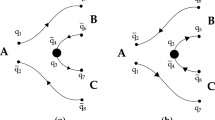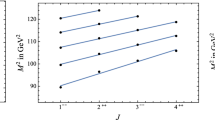Abstract
The mechanism for the formation of the \(\varLambda (1405)\) resonance is studied in a chiral quark model that includes quark-meson as well as contact (four point) interactions. The negative-parity S-wave scattering amplitudes for strangeness \(-1\) and 1 are calculated within a unified coupled-channel framework that includes the KN, \(\bar{K}N\), \(\pi \varSigma \), \(\eta \varLambda \), \(K\varXi \), \(\pi \varLambda \), and \(\eta \varSigma \) channels and possible genuine three-quark bare singlet and octet states corresponding to \(\frac{1}{2}^-\) resonances. It is found that in order to reproduce the scattering amplitudes in the \(S_{01}\) partial wave it is important to include the pertinent three-quark octet states as well as the singlet state, while the inclusion of the contact term is not mandatory. The Laurent-Pietarinen expansion is used to determine the S-matrix poles. Following their evolution as a function of increasing interaction strength, the mass of the singlet state is strongly reduced due to the attractive self-energy in the \(\pi \varSigma \) and \(\bar{K}N\) channels; when it drops below the KN threshold, the state acquires a dominant \(\bar{K}N\) component which can be identified with a molecular state. The attraction between the kaon and the nucleon is generated through the \(\bar{K}N\varLambda ^*\) interaction rather than by meson-nucleon forces.









Similar content being viewed by others
Data Availability Statement
This manuscript has no associated data or the data will not be deposited. [Authors’ comment: This is a theoretical study and no experimental data has been listed.]
Notes
In our previous calculations we have included only one or two quasi-bound quark states; in the present work we allow for more quark states.
References
M.H. Alston et al., Phys. Rev. Lett. 6, 698 (1961)
N. Isgur, G. Karl, Phys. Rev. D 18, 4187 (1978)
J.W. Darewych, R. Koniuk, N. Isgur, Phys. Rev. D 32, 1765 (1985)
S. Capstick, N. Isgur, Phys. Rev. D 34, 2809 (1986)
U. Löring, B.C. Metsch, H.R. Petry, Eur. Phys. J. A 10, 447 (2001)
T. Melde, W. Plessas, B. Sengl, Phys. Rev. D 77, 114002 (2008)
M. Arima, S. Matsui, K. Shimizu, Phys. Rev. C 49, 2831 (1994)
R.H. Dalitz, S.F. Tuan, Ann. Phys. 10, 307 (1960)
R.H. Dalitz, T.C. Wong, G. Rajasekaran, Phys. Rev. 153, 1617 (1967)
N. Kaiser, P.B. Siegel, W. Weise, Nucl. Phys. A 594, 325 (1995)
E. Oset, A. Ramos, Nucl. Phys. A 635, 99 (1998)
M.F.M. Lutz, E.E. Kolomeitsev, Nucl. Phys. A 700, 193 (2002)
J.A. Oller, U.G. Meissner, Phys. Lett. B 500, 263 (2001)
D. Jido, J.A. Oller, E. Oset, A. Ramos, U.G. Meissner, Nucl. Phys. A 725, 181 (2003)
T. Hyodo, S.I. Nam, D. Jido, A. Hosaka, Phys. Rev. C 68, 018201 (2003)
C. Garcia-Recio, J. Nieves, E.R. Arriola, M.J. Vicente Vacas, Phys. Rev. D 67, 076009 (2003)
T. Hyodo, W. Weise, Phys. Rev. C 77, 035204 (2008)
Y. Ikeda, T. Hyodo, W. Weise, Phys. Lett. B 706, 63 (2011)
Y. Ikeda, T. Hyodo, W. Weise, Nucl. Phys. A 881, 98 (2012)
Z.-H. Guo, J.A. Oller, Phys. Rev. C 87, 035202 (2013)
L. Roca, E. Oset, Eur. Phys. J. A 56, 56 (2020)
M. Mai, U.-G. Meißner, Eur. Phys. J. A 51, 30 (2015)
K.S. Myint, Y. Akaishi, M. Hassanvand, T. Yamazaki, Prog. Theor. Exp. Phys. 2018, 073D01 (2018)
A.W. Thomas, Adv. Nucl. Phys. 13, 1 (1984)
E.A. Veit, B.K. Jennings, R.C. Barrett, A.W. Thomas, Phys. Lett. B 137, 415 (1984)
E.A. Veit, B.K. Jennings, A.W. Thomas, R.C. Barrett, Phys. Rev. D 31, 1033 (1985)
B.K. Jennings, Phys. Lett. B 178, 229 (1986)
E.A. Veit, A.W. Thomas, B.K. Jennings, Phys. Rev. D 31, 2242 (1985)
B.J. Menadue, W. Kamleh, D.B. Leinweber, M.S. Mahbub, Phys. Rev. Lett. 108, 112001 (2012)
J.M.M. Hall, W. Kamleh, D.B. Leinweber, B.J. Menadue, B.J. Owen, A.W. Thomas, R.D. Young, Phys. Rev. Lett. 114, 132002 (2015)
Z.-W. Liu, J.M.M. Hall, D.B. Leinweber, A.W. Thomas, J.-J. Wu, Phys. Rev. D 95, 014506 (2017)
G.P. Engel, C.B. Lang, A. Schäfer, Phys. Rev. D 87, 034502 (2013)
P. Gubler, T.T. Takahashi, M. Oka, Phys. Rev. D 94, 114518 (2016)
R. Pavao, P. Gubler, P. Fernandez-Soler, J. Nieves, M. Oka, T.T. Takahashi, Phys. Lett. B 829, 136473 (2021)
H. Zhang, J. Tulpan, M. Shrestha, D.M. Manley, Phys. Rev. C 88, 035204 (2013)
H. Zhang, J. Tulpan, M. Shrestha, D.M. Manley, Phys. Rev. C 88, 035205 (2013)
H. Kamano, S.X. Nakamura, T.S.H. Lee, T. Sato, Phys. Rev. C 90, 065204 (2014)
M. Matveev, A.V. Sarantsev, V.A. Nikonov, A.V. Anisovich, U. Thoma, E. Klempt, Eur. Phys. J. A 55, 179 (2019)
A.V. Sarantsev, M. Matveev, V.A. Nikonov, A.V. Anisovich, U. Thoma, E. Klempt, Eur. Phys. J. A 55, 180 (2019)
H. Kamano, S.X. Nakamura, T.S.H. Lee, T. Sato, Phys. Rev. C 92, 025205 (2015)
A.V. Anisovich, A.V. Sarantsev, V.A. Nikonov, V. Burkert, R.A. Schumacher, U. Thoma, E. Klempt, Eur. Phys. J. A 56, 139 (2020)
C. Fernandez-Ramirez, I.V. Danilkin, V. Mathieu, A.P. Szczepaniak, Phys. Rev. D 93, 074015 (2016)
E. Klempt, V. Burkert, U. Thoma, L. Tiator, R. Workman, Eur. Phys. J. A 56, 261 (2020)
B. Golli, H. Osmanović, S. Širca, A. Švarc, Phys. Rev. C 97, 035204 (2018)
B. Golli, H. Osmanović, S. Širca, Phys. Rev. C 100, 035204 (2019)
B. Golli, S. Širca, Eur. Phys. J. A 38, 271 (2008)
B. Golli, S. Širca, M. Fiolhais, Eur. Phys. J. A 42, 185 (2009)
B. Golli, S. Širca, Eur. Phys. J. A 47, 61 (2011)
B. Golli, S. Širca, Eur. Phys. J. A 49, 111 (2013)
B. Golli, S. Širca, Eur. Phys. J. A 52, 279 (2016)
A. Švarc, M. Hadžimehmedović, H. Osmanović, J. Stahov, L. Tiator, R.L. Workman, Phys. Rev. C 88, 035206 (2013)
A. Švarc, M. Hadžimehmedović, R. Omerović, H. Osmanović, J. Stahov, Phys. Rev. C 89, 045205 (2014)
A. Švarc, M. Hadžimehmedović, H. Osmanović, J. Stahov, R.L. Workman, Phys. Rev. C 91, 015207 (2015)
P.A. Zyla et al. (Particle Data Group), Prog. Theor. Exp. Phys. 2020, 083C01 (2020)
R.J. Hemingway, Nucl. Phys. B 253, 742 (1985)
A. Starostin et al., Crystal Ball Collaboration. Phys. Rev. C 64, 055205 (2001)
M. Döring, U.-G. Meissner, Phys. Lett. B 704, 663 (2011)
M. Bazzi et al., SIDDHARTA Collaboration. Nucl. Phys. A 881, 88 (2012)
P.J. Fink, G. He, R.H. Landau, J.W. Schnick, Phys. Rev. C 41, 2720 (1990)
G. Agakishiev et al., (HADES Collaboration) Phys. Rev. C 87, 025201 (2013)
K. Moriya et al., CLAS Collaboration. Phys. Rev. C 87, 035206 (2013)
M. Bayar, R. Pavao, S. Sakai, E. Oset, Phys. Rev. C 97, 035203 (2018)
M. Hassanvand, S.Z. Kalantari, Y. Akaishi, T. Yamazaki, Phys. Rev. C 87, 055202 (2013)
S. Marri, M.N. Nasrabadi, S.Z. Kalantari, Phys. Rev. C 103, 055204 (2021)
W. Broniowski, B. Golli, G. Ripka, Nucl. Phys. A 703, 667 (2002)
Author information
Authors and Affiliations
Corresponding author
Additional information
Communicated by Che-Ming Ko.
Appendices
The Cloudy Bag Model meson-quark vertices and coupling constants
The s-wave quark-meson vertices \(\hat{V}(k)\) in Eq. (11) are evaluated in the Cloudy Bag Model assuming that in the resonant state one of the three quarks is excited from the 1s state to the \(1p_{1/2}\) state.
For the quark part of the quark-pion, quark-eta meson and quark-kaon interaction we obtain
Here \(\mathcal {P}_{sp} =\sum _{m_j}|sm_j\rangle \langle p_{1/2}m_j|\), \(\omega _s=2.043\), \(\omega _{p_{1/2}}=3.811\), \(X(K^0)= -(\lambda _6- i\lambda _7)/\sqrt{2}\), \(X(\bar{K}^0)= -(\lambda _6+i\lambda _7)/\sqrt{2}\), \(X(K^+)= -(\lambda _4- i\lambda _5)/\sqrt{2}\), \(X(K^-)= (\lambda _4+ i\lambda _5)/\sqrt{2}\). Assuming \(f_\eta =f_K=f_\pi \), the form-factors of the surface part and of the volume part take the form
For the physical \(\eta \) we assume \(\eta = \cos \theta _P\eta _8-\sin \theta _P\eta _1 \), for the singlet \(\eta _1\) \(\lambda _8\) is replaced by \(\lambda _1\) in Eq. (20).
The coupling constants for the s-channel exchange potential are collected in Table 4, those for the u-channel exchange potential involving strange baryons in Table 5, and for exchange of nonstrange baryons in Table 6.
Contact interaction
For the s-wave mesons the contact interaction can be cast in the form
Here \(g_{\alpha \beta }\) can be identified with \(-2f_\pi ^2\lambda ^I_{\alpha \beta }\) of [26] and \({\textstyle {\frac{1}{2}}}\mathcal {D}_{\alpha \beta }\) of [11] and are collected in Table 7.
Oset [11] has an opposite sign for \(\bar{K}N\leftrightarrow \pi \varSigma \), which is compensated by changing the sign for \(\varSigma ^*\rightarrow \pi \varSigma \).
Rights and permissions
About this article
Cite this article
Golli, B., Osmanović, H. & Širca, S. The \(\varLambda (1405)\) resonance as a genuine three-quark or molecular state. Eur. Phys. J. A 58, 116 (2022). https://doi.org/10.1140/epja/s10050-022-00767-x
Received:
Accepted:
Published:
DOI: https://doi.org/10.1140/epja/s10050-022-00767-x




